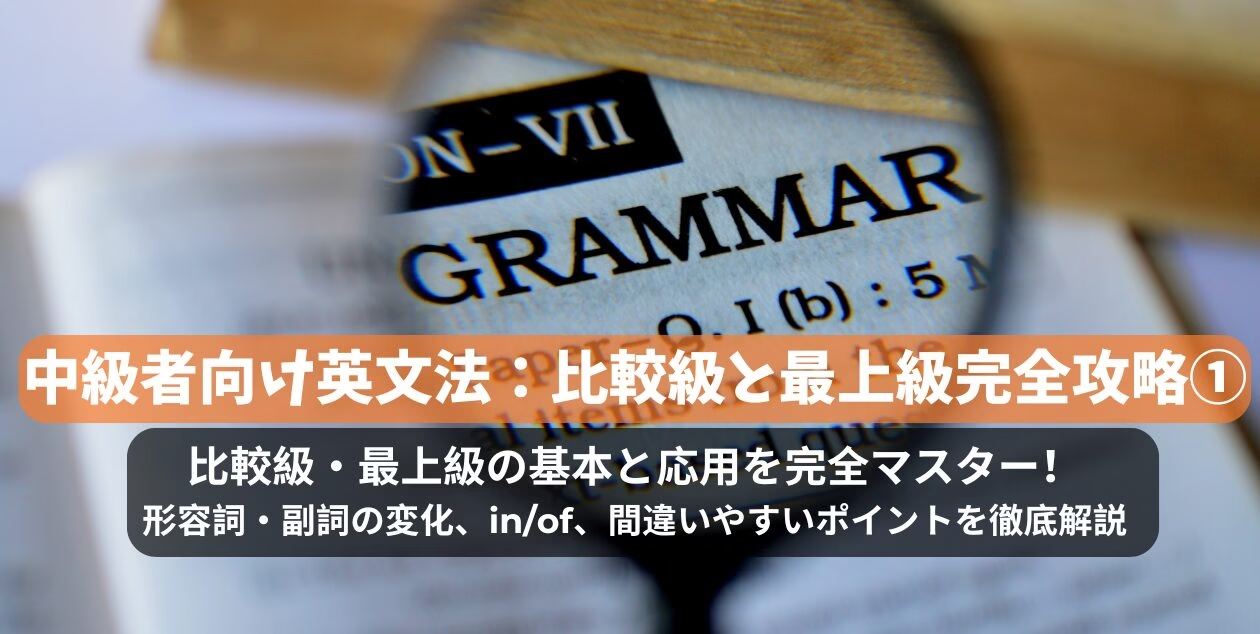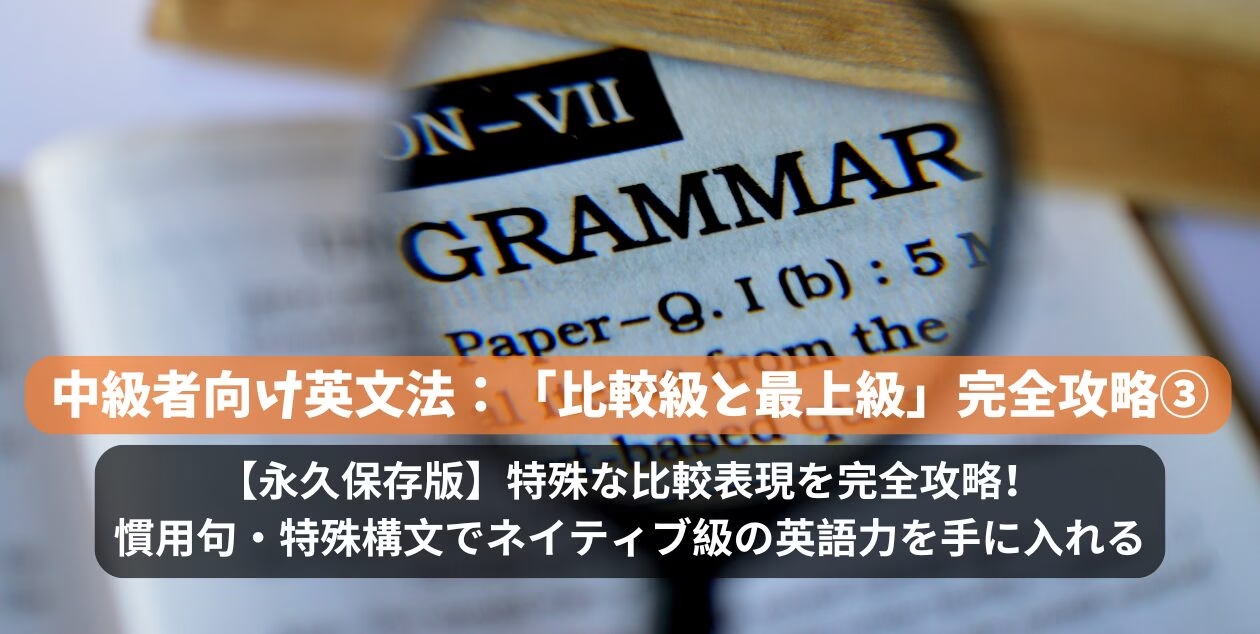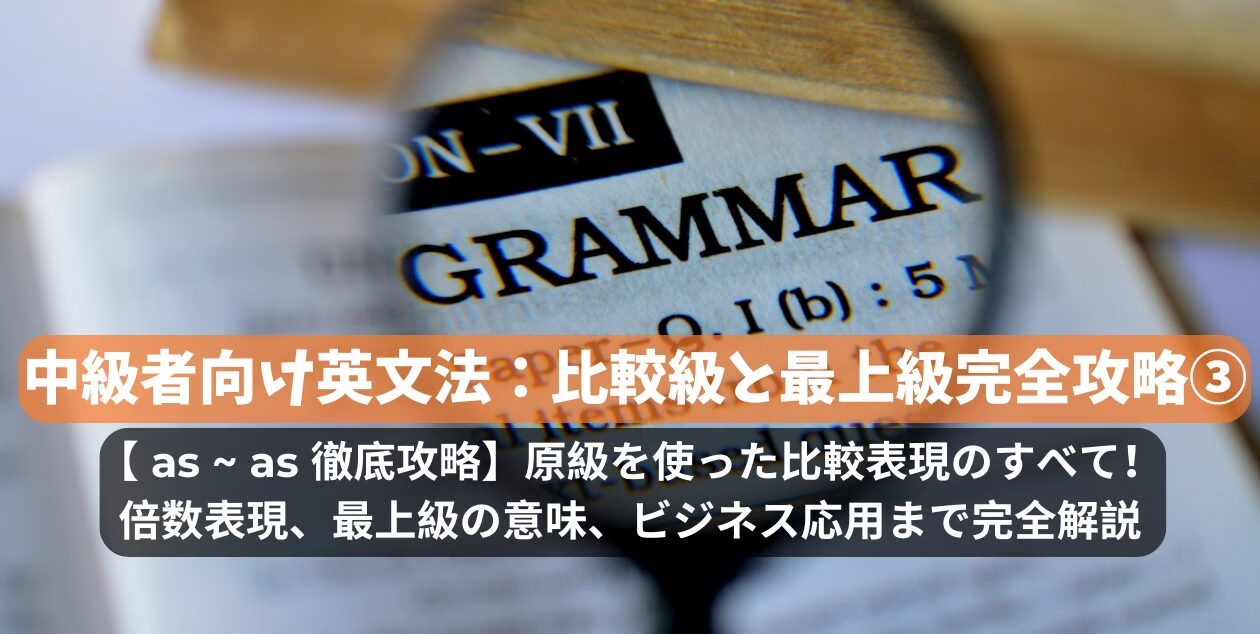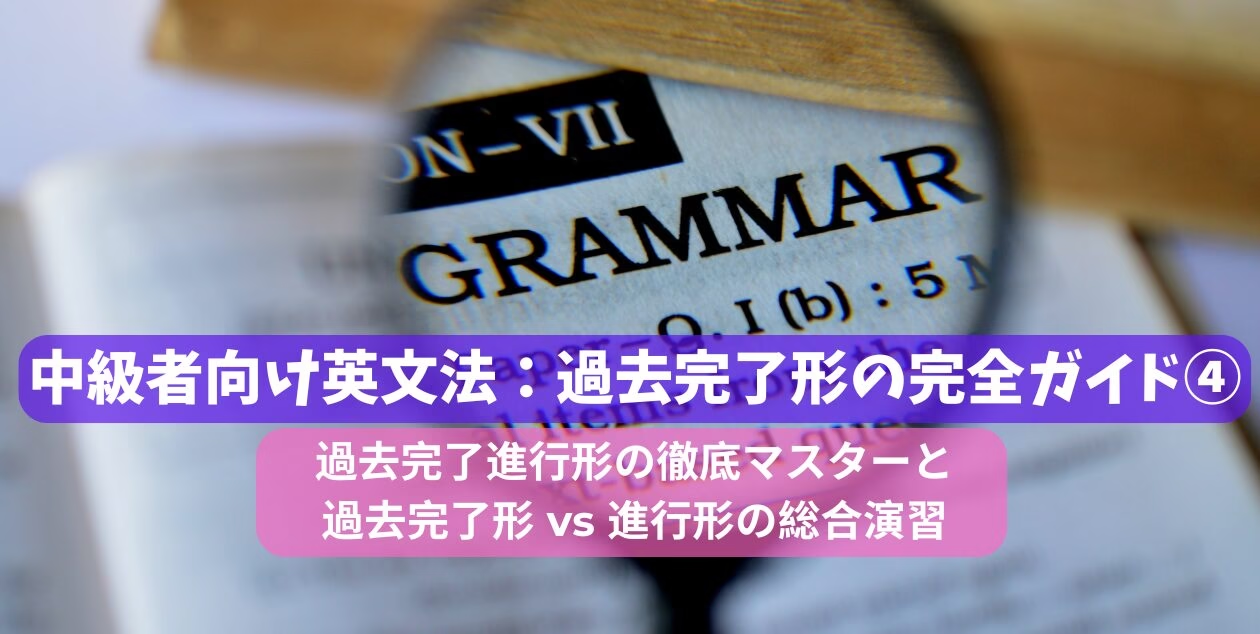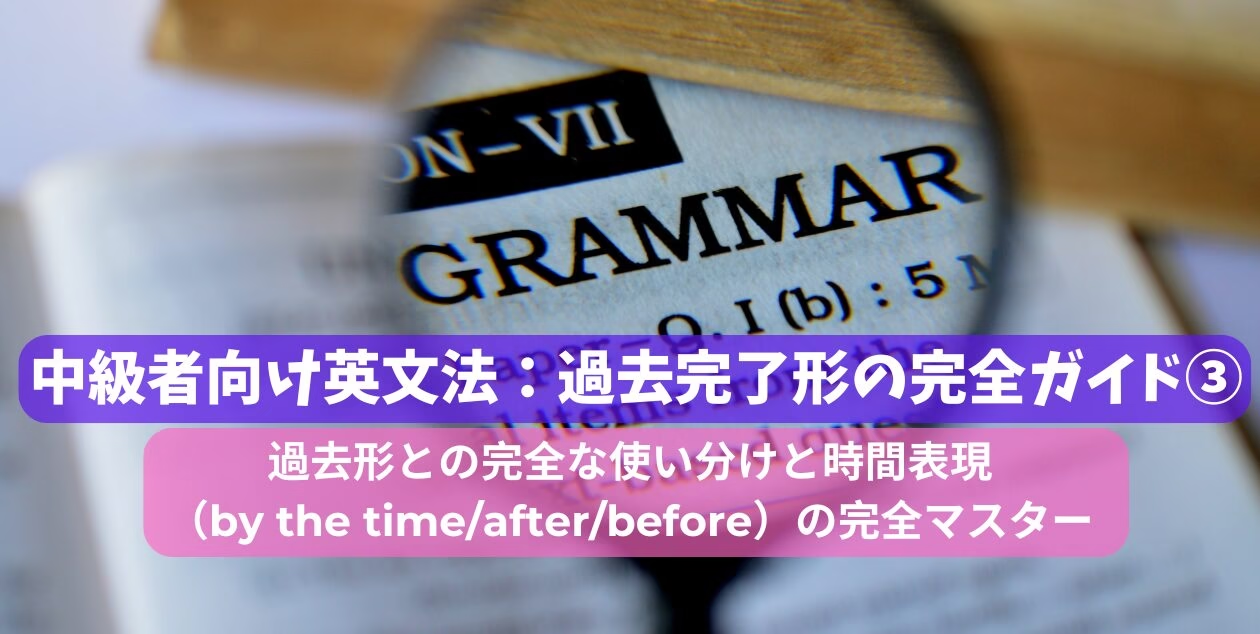比較級・最上級の基本ルール | 中級英文法マスターシリーズ
比較級と最上級は、英語表現の中でも頻出度が高く、日常会話からビジネス、学術文書まで幅広く使われる最重要文法事項です。
「なんとなく理解しているけど、正確には使い分けられない…」
そんな悩みを抱える英語学習者の方は多いのではないでしょうか?モノやコトの質的な差や絶対的な一番を正確に伝えるには、この比較表現の知識が不可欠です。
このレッスンでは、形容詞と副詞の両方における比較変化の基本ルールと複雑な例外、そして日本人が特に間違いやすいポイントを徹底的に解説します。単にルールを覚えるだけでなく、なぜその形になるのかを理解し、豊富な練習問題を通じて実践的な文法力を身につけることが目標です。
この記事を最後まで読み込めば、あなたは自信を持ってより正確で、より豊かな英語表現を使いこなせるようになるでしょう。さあ、一緒に比較級・最上級のマスターを目指しましょう!
1. 比較級と最上級の役割を理解する

比較級とは
比較級は2つの対象を比べて「より~である」を表現します。
実際の使用例を見てみましょう:
値段の比較
This shirt is cheaper than that one.
(このシャツはあれより安い)
能力の比較
She speaks English more fluently than me.
(彼女は私より流暢に英語を話す)
最上級とは
最上級は3つ以上の対象から「最も~である」を示します。
こちらも実例を見てみます:
商品評価
This is the most comfortable chair in the store.
(これは店内で最も快適な椅子です)
地域特性
Mount Fuji is the highest mountain in Japan.
(富士山は日本一高い山です。)
2. 比較級と最上級の違いを明確にする

英語学習者がしばしば混同しやすいこの2つの概念を、表で比較してみましょう。
| 項目 | 比較級 | 最上級 |
|---|---|---|
| 比較する対象数 | 2つ | 3つ以上 |
| 意味 | 「より~だ」「~よりも~だ」 | 「一番~だ」「最も~だ」 |
| 文法構造 | 比較対象を「than」でつなぐ | 「the」をつけ、範囲を「in/of」で示す |
| 例文 | She is taller than me. | She is the tallest in the class. |
最大の違い:比較の対象範囲
比較級は「2つのもの間の相対的な差」を表現するのに対し、最上級は「複数の中での絶対的な一番」を示します。この概念的な違いを理解することが、適切な使い分けの第一歩です。
3. 形容詞の比較級:規則変化と例外

形容詞の比較級を作る際には、単語の長さとつづりが重要な役割を果たします。以下のルールに従いましょう。
長さによる変化の違い
短い形容詞(1音節、または一部2音節)
語尾に-erを付けます。
| 原級 | 比較級 |
|---|---|
| tall | taller |
| fast | faster |
| big | bigger |
| hot | hotter |
使用例:
My bag is lighter than yours.
(私のバッグはあなたのより軽い)
長い形容詞(3音節以上、または-ing, -ous, -fulなどで終わるもの)
前にmoreを付けます。
| 原級 | 比較級 |
|---|---|
| interesting | more interesting |
| beautiful | more beautiful |
| expensive | more expensive |
| comfortable | more comfortable |
使用例:
This movie is more interesting than the last one.
(この映画は前作より面白い)
2音節の形容詞
2音節の形容詞は最も複雑です。以下のルールが適用されます:
- -y, -er, -ow, -le で終わるものは-erを付ける
- happy → happier
- clever → cleverer
- narrow → narrower
- simple → simpler
- それ以外は一般的にmoreを使う
- famous → more famous
- polite → more polite
つづり(スペル)の注意点
比較級を作る際、単語のつづりが変わることがあります。以下のパターンに注意しましょう。
パターン1:短母音+子音字で終わる単語
最後の子音字を重ねてから-erを付けます。
| 原級 | 比較級 | 理由 |
|---|---|---|
| big | bigger | 短母音+子音 |
| hot | hotter | 短母音+子音 |
| sad | sadder | 短母音+子音 |
| thin | thinner | 短母音+子音 |
パターン2:子音+yで終わる単語
yをiに変えてから-erを付けます。
| 原級 | 比較級 | 規則 |
|---|---|---|
| happy | happier | y→i+er |
| easy | easier | y→i+er |
| busy | busier | y→i+er |
| lazy | lazier | y→i+er |
不規則変化:暗記が必要なもの
すべての形容詞が規則に従うわけではありません。以下の不規則変化は個別に覚える必要があります。
| 原級 | 比較級 | 最上級 |
|---|---|---|
| good | better | best |
| bad | worse | worst |
| far | farther/further | farthest/furthest |
| little | less | least |
| many/much | more | most |
使用例:
This is a better option than that one.
(これはあれより良い選択肢です)
4. 形容詞の比較級:実践練習

以下の練習問題で、学習内容を定着させましょう。
練習問題
📝 Part 1:選択式(基本理解)
Q1. 次の文の空欄に入る正しい語を選びなさい。
This bag is ______ than mine.
(a) light (b) lighter (c) lightest
Q2. 次の文で最も自然な語を選びなさい。
This is the ______ building in the city.
(a) tall (b) taller (c) tallest
Q3. 次のうち比較級を使うべき文はどれ?
(a) 3つのレストランの中で一番おいしい
(b) AとBのどちらがより安いか
(c) 世界で一番高い山はどれか
Q4. 次の単語の比較級として正しいものを選びなさい。
famous
(a) famouser (b) more famous (c) most famous
📝 Part 2:穴埋め(変化のルール)
Q5. 次の文を比較級に書き換えなさい。
She is happy.
→ She is ______ than before.
Q6. 次の語を比較級にしなさい。
big → ___________
Q7. 次の語を比較級にしなさい。
busy → ___________
Q8. 次の語を最上級にしなさい。
good → ___________
📝 Part 3:誤り訂正(よくあるミス)
Q9. 誤りを訂正しなさい。
This chair is comfortabler than that one.
Q10. 誤りを訂正しなさい。
She is the most tall in the class.
Q11. 誤りを訂正しなさい。
Mount Fuji is higher than all mountains in Japan.
Q12. 誤りを訂正しなさい。
He runs more fast than me.
📝 Part 4:英作文(和文→英文)
Q13.
この映画は前作より面白い。
→ ________________________________
Q14.
富士山は日本で一番高い山です。
→ ________________________________
Q15.
このシャツはあれより安いです。
→ ________________________________
Q16.
彼女は私より流暢に英語を話します。
→ ________________________________
解答 & 解説
A1. (b) lighter
→ 1音節の形容詞“light” は -er を付ける。比較級・最上級の基本ルール
A2. (c) tallest
→ 3つ以上に対しては the + 最上級 を使う。比較級・最上級の基本ルール
A3. (b)
→ 比較級は「2つのものの比較」。
(a)(c)は複数対象なので最上級。比較級・最上級の基本ルール
A4. (b) more famous
→ famous は2音節だが -ous で終わるため more + 形容詞 を使用。
A5. happier
→ 子音 + y の語は y → i + er(happy → happier)。比較級・最上級の基本ルール
A6. bigger
→ 短母音 + 子音なので子音を重ねて -er(big → bigger)。比較級・最上級の基本ルール
A7. busier
→ busy → busier(y → i の綴り変化)。比較級・最上級の基本ルール
A8. best
→ good は完全不規則(good → better → best)。
A9. more comfortable
→ comfortable は長い形容詞(-able) → more + 形容詞。比較級・最上級の基本ルール
A10. the tallest
→ tall は1音節 → -est で最上級。比較級・最上級の基本ルール
A11. the highest mountain in Japan
→ 「日本の中で最も高い山」 → 最上級 + in を使うべき。比較級・最上級の基本ルール
A12. faster
→ fast は規則変化 → fast → faster。
“more fast” とは言わない。
A13.
This movie is more interesting than the previous one.
→ interesting は長い形容詞なので more。比較級・最上級の基本ルール
A14.
Mount Fuji is the highest mountain in Japan.
→ 最上級 + in(範囲)。比較級・最上級の基本ルール
A15.
This shirt is cheaper than that one.
→ cheap の比較級は cheaper。比較級・最上級の基本ルール
A16.
She speaks English more fluently than me.
→ 副詞 fluently は長い形 → more + 副詞。比較級・最上級の基本ルール
5. 副詞の比較級:形容詞との違いを理解する

英語学習者が特に混同しやすいのが、形容詞と副詞の使い分けです。比較級を作る前に、この違いをしっかり理解しましょう。
形容詞と副詞の本質的な違い
形容詞の役割
- 名詞や代名詞を修飾します
- 文中では補語(C)になれます
- “He gave the correct answer.” →「correct」は名詞「answer」を修飾
副詞の役割
- 動詞、形容詞、他の副詞、文全体を修飾します
- 補語にはなれません
- “He answered correctly.” →「correctly」は動詞「answered」を修飾
具体例で学ぶ形容詞と副詞
| 文 | 修飾する品詞 | 例 |
|---|---|---|
| She is a good singer. | 名詞 | 形容詞 |
| She sings well. | 動詞 | 副詞 |
| He is careful. | 補語(状態) | 形容詞 |
| He drives carefully. | 動詞 | 副詞 |
| He is very tall. | 形容詞 | 副詞 |
副詞の主な語尾と特徴
多くの副詞は形容詞に–lyを付けて作られます:
- quick → quickly
- happy → happily
- careful → carefully
ただし、一部の副詞は形が変わりません:
- fast → fast(形が変わらない)
- hard → hard(形が変わらない)
- late → late(形が変わらない)
6. 副詞の比較級:作り方と活用

形容詞と同様に、副詞も規則と例外に従って比較級を作ります。
短い副詞(1音節)
語尾に-erを付けます。
| 原級 | 比較級 | 使用例 |
|---|---|---|
| fast | faster | He arrived faster than expected. |
| hard | harder | She works harder than before. |
| early | earlier | I woke up earlier than usual. |
| late | later | He came later than planned. |
長い副詞(-lyで終わるもの)
前にmoreを付けます。
| 原級 | 比較級 | 使用例 |
|---|---|---|
| carefully | more carefully | Drive more carefully on rainy days. |
| quickly | more quickly | She answered more quickly than I expected. |
| easily | more easily | This problem is solved more easily with this method. |
| clearly | more clearly | He explains things more clearly now. |
副詞の不規則変化
| 原級 | 比較級 | 使用例 |
|---|---|---|
| well | better | She sings better than her brother. |
| badly | worse | He behaved worse than yesterday. |
| far | farther/further | He ran farther than anyone. |
| little | less | She eats less than before. |
副詞の比較級で気をつけるポイント
重要1:theを使わない
形容詞の比較級では「the」を使いませんが、副詞の比較級でも同様です。
- ✗ He runs the faster than me.
- ○ He runs faster than me.
重要2:比較対象を明確にする
「than」を使って比較対象をはっきり示しましょう。
- “She studies harder than me.”
- “He works more efficiently than his colleagues.”
重要3:強調表現の活用
much, a lot, far, even などを比較級の前に置くと、より強い比較を表現できます。
- “He can run much faster than before.”
- “She speaks far more fluently than I do.”
7. 副詞の比較級:実践練習

Part 1|形容詞 or 副詞?どちらを使う?(1〜3)
文脈から 形容詞(Adj.) または 副詞(Adv.) のどちらを入れるべきか選び、正しい形にしなさい。
- She sings (beautiful / beautifully) than before.
- He is a (quick / quickly) learner.
- He answered the question (correct / correctly).
Part 2|副詞の比較級を作る(4〜6)
次の副詞を比較級にしなさい。
- fast
- carefully
- well
Part 3|文を完成させる(7〜10)
カッコ内の語を副詞の比較級にして文を完成させなさい。
- She works ______ than me. (hard)
- Please drive ______ on snowy roads. (slowly)
- He ran ______ than anyone in the race. (far)
- This problem can be solved ______ with this tool. (easily)
✅ 【解答と解説】
- beautifully
→ 動詞 sings を修飾 → 副詞
→ 比較なので more beautifully とするのが自然。
正解:She sings more beautifully than before. - quick
→ learner(名詞)を修飾 → 形容詞
正解:He is a quick learner. - correctly
→ answered(動詞)を修飾 → 副詞
正解:He answered the question correctly. - faster
1音節 → er - more carefully
-ly で終わる → more + 副詞 - better
不規則変化 - harder
She works harder than me.
→ hard は形が変わらない副詞 → 比較級は harder - more slowly
Please drive more slowly on snowy roads.
→ slowly は -ly の副詞 → more をつける。 - farther / further
He ran farther than anyone in the race.
※ further でも可
→ far の比較級は farther / further - more easily
This problem can be solved more easily with this tool.
→ easily は -ly → more を付けて比較級
8. 形容詞の最上級:基本構造と作り方

最上級の役割
最上級は3つ以上のものの中で「最も~だ」「一番~だ」という絶対的な優位性を表現します。
短い形容詞の最上級
語尾に-estを付け、前にtheを置きます。
| 原級 | 最上級 | 使用例 |
|---|---|---|
| tall | the tallest | She is the tallest in the class. |
| fast | the fastest | He is the fastest runner. |
| busy | the busiest | This is the busiest season. |
| big | the biggest | This is the biggest problem. |
長い形容詞の最上級
前にthe mostを付けます。
| 原級 | 最上級 | 使用例 |
|---|---|---|
| beautiful | the most beautiful | This is the most beautiful flower. |
| expensive | the most expensive | That’s the most expensive option. |
| interesting | the most interesting | It was the most interesting lecture. |
| popular | the most popular | She’s the most popular singer. |
最上級のつづり(スペル)ルール
比較級と同様に、つづりが変わるパターンがあります:
パターン1:短母音+子音字で終わる単語 → 最後の子音を重ねてから-estを付けます。
| 原級 | 最上級 |
|---|---|
| big | the biggest |
| hot | the hottest |
| sad | the saddest |
パターン2:子音+yで終わる単語 → yをiに変えてから-estを付けます。
| 原級 | 最上級 |
|---|---|
| happy | the happiest |
| busy | the busiest |
| lazy | the laziest |
形容詞の不規則変化(重要)
| 原級 | 比較級 | 最上級 | 使用例 |
|---|---|---|---|
| good | better | best | He is the best singer. |
| bad | worse | worst | This is the worst movie. |
| many | more | most | She has the most books. |
| much | more | most | He did the most work. |
| little | less | least | This is the least expensive. |
| far | farther/further | farthest/furthest | Mt. Fuji is the farthest. |
| old | older/elder | oldest/eldest | She is the eldest sister. |
範囲の示し方:inとofの違い
最上級を使う際、「何の中で一番なのか」を明確に示すことが重要です。inとofの使い分けをマスターしましょう。
- 「in」を使う場合
-
場所やグループ、組織など広い範囲で一番を表します。
- “She is the tallest student in the class.”
(彼女はクラスで一番背が高い) - “This is the best restaurant in town.”
(これは町で一番のレストラン) - “He is the most popular singer in Japan.”
(彼は日本で一番人気の歌手)
- “She is the tallest student in the class.”
- 「of」を使う場合
-
具体的な人数や限定された集まり、複数の選択肢など個々の関係で一番を表します。ofの後には「the+数字」「all」などが続くことが多いです。
- “She is the smartest of the three.”
(彼女は3人の中で一番頭が良い) - “This is the most expensive of all the products.”
(これは全商品の中で一番高い) - “He is the youngest of all.”
(彼は全員の中で一番若い)
- “She is the smartest of the three.”
使い分けの実践例
| 文脈 | 前置詞 | 例 |
|---|---|---|
| 学校全体 | in | the best school in the district |
| 3人の兄弟姉妹 | of | the tallest of the three |
| 町全体 | in | the biggest building in the city |
| 全員の中 | of | the fastest runner of all |
| 家族 | in/of | the youngest in/of the family |
9. 形容詞の最上級:実践練習

Part 1|最上級を作る(1〜4)
カッコ内の形容詞を最上級の形にしなさい。
- tall → the ______
- busy → the ______
- interesting → the ______
- good → the ______
Part 2|文を完成させなさい(5〜7)
カッコ内の語を最上級にして正しい文を作りなさい。
- This is (beautiful) flower in the garden.
- He is the (young) of the three brothers.
- This building is the (big) in the city.
Part 3|in / of の使い分け(8〜10)
文脈に合うほうを選びなさい。
- She is the smartest (in / of) the class.
- He is the tallest (in / of) the three boys.
- This is the best restaurant (in / of) all the restaurants here.
✅ 【解答と解説】
- the tallest
→ 短い形容詞 → -est - the busiest
→ 子音+y → y→i に変えて -est - the most interesting
→ 長い形容詞 → the most + 形容詞 - the best
→ 不規則変化:good → better → best - This is the most beautiful flower in the garden.
→ beautiful は長い形容詞 → the most + 形容詞
→ 範囲「庭の中で」= in - He is the youngest of the three brothers.
→ young → youngest
→ 3人の中という「人数の限定」→ of - This building is the biggest in the city.
→ big → 子音重ねのスペル → biggest
→ 町という広い範囲 → in - in
She is the smartest in the class.
→ クラスというグループ=広い範囲 → in - of
He is the tallest of the three boys.
→ 「3人の中で」=限定された人数 → of - of
This is the best restaurant of all the restaurants here.
→ “all the restaurants” =個別比較の集合 → of(in も文法的に可能だが、of all the ~ がより自然)
10. 副詞の最上級:概念と作り方

副詞の最上級の役割
副詞の最上級は、3つ以上の動作や状態を比べて「最も~に」「一番~く」を表します。
使用例:“He runs (the) fastest in his class.”
(彼はクラスで一番速く走ります)
短い副詞の最上級
語尾に-estを付けます。多くの場合、theは省略可能です。
| 原級 | 最上級 |
|---|---|
| fast | (the) fastest |
| hard | (the) hardest |
| early | (the) earliest |
| late | (the) latest |
使用例:
“He arrived (the) earliest of all.”
(彼は全員の中で一番早く到着した)
長い副詞の最上級
前にmostを付けます。theは省略可能です。
| 原級 | 最上級 |
|---|---|
| carefully | (the) most carefully |
| quickly | (the) most quickly |
| easily | (the) most easily |
| politely | (the) most politely |
使用例:
“She speaks (the) most politely in the class.”
(彼女はクラスで一番丁寧に話す)
副詞の不規則変化
形容詞と同じ形を使用します:
| 原級 | 最上級 | 使用例 |
|---|---|---|
| well | (the) best | She sings (the) best in our group. |
| badly | (the) worst | He behaved (the) worst of all. |
| far | (the) farthest/furthest | He ran (the) farthest in the race. |
| little | (the) least | She eats (the) least at lunch. |
theの省略について
副詞の最上級では、theは省略可能な場合が多いです。
“He can swim (the) fastest in our class.”
(どちらの表現も正しいですが、口語では省略することが多い)
範囲の表し方
形容詞と同様に、inとofを使って範囲を明確にします:
“She arrived (the) earliest in the group.”
(彼女はグループで一番早く到着した)
“He speaks English (the) most fluently of all.”
(彼は全員の中で一番流暢に英語を話す)
強調表現
by far, much, far などを副詞の最上級の前に置くと「飛びぬけて一番~」を表現できます:
“He ran by far the fastest in the race.”
(彼はレースで飛びぬけて一番速かった)
11. 副詞の最上級:実践練習

Part 1:語形変化(基礎)
次の副詞を最上級の形にしなさい。
- fast → _________
- carefully → _________
- well → _________
- hard → _________
- politely → _________
Part 2:文を完成させなさい(語形変化+文法)
括弧内の語を最上級の形にし、文を完成させなさい。the は必要なら入れなさい。
- He runs __________ in his team.
(fast) - She speaks English __________ of all the students.
(fluently) - Tom finished the test __________ in the class.
(early) - She treated the customers __________ in our shop.
(politely) - He can jump __________ in the group.
(far)
Part 3:和訳に合うように英語を書きなさい
- 彼女は全員の中で一番上手に歌います。
→ She sings __________________________. - 彼はレースで飛びぬけて一番速く走った。
→ He ran __________________________. - 彼はクラスで一番悪くふるまった。
→ He behaved __________________________.
Part 4:誤り訂正(実用問題)
- ❌ He arrived the most earliest of all.
→ 正しい文に直しなさい。 - ❌ She spoke the best politely in the group.
→ 正しい文に直しなさい。
✅ 解答と解説
- (the) fastest
- (the) most carefully
- (the) best(不規則)
- (the) hardest
- (the) most politely
- (the) fastest
fast → fastest
「走る」の速さを比較しているので副詞の最上級。 - (the) most fluently
- 長い副詞なので most + 副詞。
- (the) earliest
- early → earliest(短い副詞は -est)
- (the) most politely
- politely は長い副詞 → most politely
- (the) farthest / furthest
far の最上級はどちらも可。距離なのでどちらでも正しい。 - She sings (the) best of all.
※well → best(不規則) - He ran by far the fastest in the race.
※by far で「飛びぬけて」 - He behaved (the) worst in his class.
※badly → worst - He arrived (the) earliest of all.
早い(early)は short 副詞 → earliest
most earliest(重複)は誤り - She spoke (the) most politely in the group.
politely は long 副詞 → most politely
best politely は意味不明(最上級の重複)
13. よくある間違いと対策

英語学習者が比較級・最上級で犯しやすいミスをまとめました。自分の学習に照らし合わせてみてください。
間違い1:比較級と最上級の混同
✗ 誤った使い方
- “She is the taller than me.” (比較級なのにtheを使用)
- “She is taller in the class.” (最上級なのに比較級(taller)を使用)
○ 正しい使い方
- “She is taller than me.”
- “She is the tallest in the class.”
間違い2:形容詞と副詞の混同
✗ 誤った使い方
- “He speaks English more fluent than me.”(形容詞を使用)
○ 正しい使い方
- “He speaks English more fluently than me.”(副詞を使用)
間違い3:theの誤使用・省略
✗ 誤った使い方
- “He runs the faster than me.”(副詞の比較級にtheを使用)
- “This is the most comfortable chair.”(範囲を示さない)
○ 正しい使い方
- “He runs faster than me.”
- “This is the most comfortable chair in the store.”
間違い4:不規則変化の誤用
✗ 誤った使い方
- “This is more good than that.” (goodは不規則変化)
- “He is gooder than her.” (-erを付けるのは誤り)
○ 正しい使い方
- “This is better than that.”
- “He is better than her.”
間違い5:つづり変化の誤り
✗ 誤った使い方
- “The weather is hoter than yesterday.” (tは重ねていない)
- “She is happyer than before.” (yをiに変えていない)
○ 正しい使い方
- “The weather is hotter than yesterday.” (短母音+子音なのでtを重ねる)
- “She is happier than before.” (y→i+er)
14. 音節の数え方:実践的なガイド

「短い」「長い」という判断は音節数が基準です。正確に数えられるようになりましょう。
音節の数え方の基本
英語の音節は、原則として母音ごとに1つです。以下の例を参考にしてください。
| 単語 | 分解 | 音節数 | 分類 |
|---|---|---|---|
| big | big | 1 | 短い |
| happy | hap-py | 2 | 2音節 |
| beautiful | beau-ti-ful | 3 | 長い |
| interesting | in-ter-est-ing | 4 | 長い |
| comfortable | com-for-ta-ble | 4 | 長い |
| clever | clev-er | 2 | 2音節 |
| famous | fa-mous | 2 | 2音節 |
| polite | po-lite | 2 | 2音節 |
判断基準のまとめ
| 音節数 | 判断 | 比較級の作り方 | 例 |
|---|---|---|---|
| 1音節 | 短い | -er | tall → taller |
| 2音節(-y, -er, -ow, -le) | 短い | -er | happy → happier |
| 2音節(その他) | 長い傾向 | more | famous → more famous |
| 3音節以上 | 長い | more | beautiful → more beautiful |
15. 比較表現の強調方法

比較級・最上級をより効果的に表現するための強調表現を学びましょう。
比較級を強調する表現
much, a lot, far, even などを比較級の前に置くと、より強い比較を表現できます。
| 強調表現 | 使用例 | 意味 |
|---|---|---|
| much | She is much taller than me. | ずっと背が高い |
| a lot | This is a lot cheaper than that. | かなり安い |
| far | He runs far faster than before. | 非常に速く走る |
| even | It’s even better than expected. | さらに良い |
| by far | This is by far the best option. | 群を抜いて最高 |
最上級を強調する表現
by far, much, far を最上級の前に置くと、より強い最上級を表現できます。
He is by far the best singer in the world.
(彼は世界で群を抜いて最高の歌手だ)
This is by far the most expensive item in the store.
(これは店で群を抜いて最も高い商品だ)
16. 状況別の使い分け実例

比較級と最上級をどのような場面で使い分けるのか、実際の会話場面を想定した例を見てみましょう。
場面1:日常会話での製品比較
場面: 店員と顧客がイヤホンを比較している
顧客: “This one sounds better than that one, right?”
(これはあれより音がいいですね?)
店員: “Yes, but the most expensive model has even better sound quality.”
(はい、ですが最も高いモデルがさらに優れた音質を持っています)
場面2:学校での成績比較
場面: 生徒が先生に成績について相談している
生徒: “My math score is lower than my English score.”
(数学のスコアは英語より低いです)
先生: “You’re the hardest worker in the class, so you’ll improve.”
(あなたはクラスで一番勤勉ですから、必ず伸びます)
場面3:旅行計画での比較
場面: 友人同士が旅行先を決めている
友人A: “Japan is more interesting than Korea in my opinion.”
(私の意見では日本は韓国より興味深い)
友人B: “But Thailand has the most beautiful beaches of all three countries.”
(でもタイは3か国の中で最も美しいビーチを持ってる)
17. 総合演習問題(中級レベル)

これまで学んだすべての内容を統合した問題に挑戦してください。
問題セットA:穴埋め問題
問題A-1: The new restaurant is much __________ (good) than the old one.
問題A-2: She is __________ (intelligent) person I have ever met.
問題A-3: He works __________ (hard) than his colleagues.
問題A-4: This problem is __________ (complicated) than it appears.
問題A-5: Of all the team members, she runs __________ (fast).
問題セットB:文法判定問題
以下の文が正しいか、誤っているかを判定し、誤っている場合は正しい形に修正してください。
問題B-1: “This shirt is the cheaper than that one.”
問題B-2: “He speaks English more fluent than his brother.”
問題B-3: “She is the most intelligent in her class.”
問題B-4: “He arrived the earlier than expected.”
問題B-5: “This is the most beautiful flower of all the flowers in the garden.”
問題セットC:日本語から英語への翻訳
日本語を英語に訳してください。
問題C-1: このコンピュータはあれより速いです。
問題C-2: 彼女はクラスで最も背が高い学生です。
問題C-3: 彼は妹より注意深く運転します。
問題C-4: これは私が今まで読んだ中で最も興味深い本です。
問題C-5: 全員の中で、彼女が一番早く宿題を終わらせました。
解答
問題A-1: better
解説: goodは不規則変化で比較級はbetter。muchで強調しています。
問題A-2: the most intelligent
解説: intelligentは3音節の長い形容詞。最上級なのでthe most intelligentです。
問題A-3: harder
解説: hardは短い副詞。比較級なので-erで「harder」です。
問題A-4: more complicated
解説: complicatedは4音節の長い形容詞。比較級なのでmore complicatedです。
問題A-5: (the) fastest
解説: fastは短い副詞。最上級なので-estで「fastest」(theは省略可能)です。
問題B-1: ✗ 誤り
理由: 比較級なのに「the」を使っています。最上級ではなく2つの対象を比較しているので「the」は不要です。
正しい形: “This shirt is cheaper than that one.”
問題B-2:✗ 誤り
理由: 動詞を修飾しているので副詞を使う必要があります。形容詞「fluent」ではなく副詞「fluently」を使います。
正しい形: “He speaks English more fluently than his brother.”
問題B-3: ✓ 正しい
理由: 最上級で、3人以上の中での一番を表しており、範囲を「in her class」で示しています。文法的に正確です。
問題B-4: ✗ 誤り
理由: 副詞の比較級は「the」を使いません。また、比較級と最上級を混同しています。
正しい形: “He arrived earlier than expected.”
問題B-5:✓ 正しい
理由: 最上級を正しく使い、範囲を「of all the flowers in the garden」で明確に示しています。
問題C-1: “This computer is faster than that one.”
解説: fast(短い形容詞)の比較級。「than」で比較対象を示します。
問題C-2: “She is the tallest student in the class.”
解説: tall(短い形容詞)の最上級。範囲を「in the class」で示します。
問題C-3: “He drives more carefully than his sister.”
解説: carefully(-lyで終わる副詞)の比較級。前に「more」を置きます。
問題C-4: “This is the most interesting book I have ever read.”
解説: interesting(長い形容詞)の最上級。「the most」を使います。
問題C-5: “Of all the students, she finished her homework the most quickly.”
または、”She finished her homework the quickest of all.”(口語的)
解説: 副詞の最上級。「of all」で範囲を示します。最上級では「the」を付けることが多いですが、口語では省略されることもあります。
学習者からよくある質問

- 「more tall」と「taller」、どちらを使うべきですか?
-
「taller」が正しいです。短い形容詞(1音節)は -er を使います。「more tall」は文法的に誤りです。
- 2音節の形容詞はいつ -er を使い、いつ more を使いますか?
-
-y, -er, -ow, -le で終わるものは -er を使う傾向が強いです。他の2音節形容詞は more を使うことが多いです。迷ったら more を使う方が安全です。
- 副詞の最上級で「the」は必ず必要ですか?
-
文法的には「the」があってもなくても両方正しいとされていますが、より正式な表現では「the」を含める傾向があります。
- 「farther」と「further」の違いは何ですか?
-
「farther」は物理的な距離に、「further」は抽象的な進展や程度に使い分けることが多いです。ただし、実際の会話ではどちらでも許容される場合が多いです。
- 最上級で「in」と「of」が両方使える場合はありますか?
-
あります。「in my family」と「of my family」は文脈によって両方使えることがあります。「in」はより自然で、「of」はより限定的なニュアンスを持ちます。
まとめ

総括:比較級・最上級マスターへの道
本記事では、比較級と最上級の役割から、形容詞と副詞の複雑な変化ルール、さらには最上級における “the”の使い方や “in” / “of” の使い分けまで、網羅的に学習しました。
この知識は、あなたの英語の正確性(Accuracy)と表現力(Fluency)を飛躍的に向上させます。最後に、学んだ知識を定着させるためのチェックリストと、今後の学習に役立つアドバイスをご確認ください。
✔ 最終チェックリスト
| 項目 | 確認内容 |
| 役割 | 比較級は2つ、最上級は3つ以上を比較しているか? |
| 基本変化 | 短い単語は -er / -est、長い単語は more / most を正しく使えているか? |
| 必須要素 | 比較級には than、最上級(形容詞)には the を必ず付けているか? |
| 品詞の区別 | 名詞を修飾する際は形容詞、動詞や副詞を修飾する際は副詞を使っているか? |
| 例外 | good/better/best, bad/worse/worst などの不規則変化を暗記しているか? |
| 最上級の範囲 | in(場所・グループ)と of(限定的な集まり・数)を適切に使い分けているか? |
⭐ 学習定着のためのアドバイス
- 意識的なアウトプットを増やす: 文法書を読むだけでなく、日常の中で「AはBより〜だ」「これは一番〜だ」という比較表現を使う機会を探しましょう。例えば、食べ物や映画の感想を述べる際に意識的に比較級や最上級を使う練習をしてください。
- 不規則変化を「塊」で覚える: Good, better, best のように、原級・比較級・最上級をセットで音読し、リズムで覚えましょう。これらは非常に頻出するため、考えることなく口から出るように訓練することが重要です。
- リスニングで「the」に注目する: ネイティブの英語を聞くとき、最上級の前に the があるか、副詞の最上級で the が省略されているか、などに注意して聞く習慣をつけましょう。文法的な気づきは、リスニング力の向上にも繋がります。
このレッスンで学んだ知識を土台に、さらなる英文法マスターを目指してください。次のレッスン(Part 2)では、原級を使った比較表現を学習します!
📖 さらなる英語学習をお考えの方へ
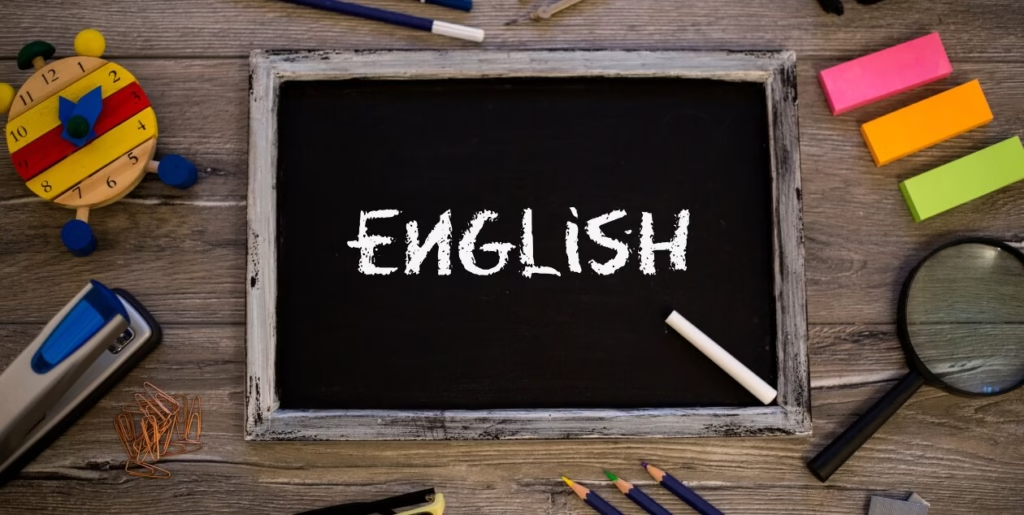
基礎から学び直したい方はこちら

語彙力を強化したい方はこちら
本格的な英語学習方法を知りたい方はこちら
このガイドは、35年以上の英語教育経験を持つ矢野晃によって作成されました。数千人の講師を育て数千人の生徒を指導してきた実績に基づく、実践的で効果的な学習方法をお届けしています。




